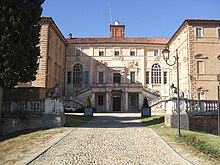Castle of Govone
The Castle of Govone ( Italian Castello di Govone ) is located in the municipality of Govone , in the Italian region of Piedmont .
The castle was owned by the kings of Piedmont-Sardinia from 1792 to 1849 . Since 1997, it has been part of the World Heritage Residences of the Royal House of Savoy along with their other residences . The first floor, the bel étage , is open to the public. A citizens' association organizes the visits and events in cooperation with the municipal administration.
history
In the Middle Ages, a guard and defense system arose on the site of today's castle, which, together with extensive lands, was given to the Count Solaro as a fief.
At the end of the 17th century they commissioned the architect Guarino Guarini to draw up a plan for a baroque palace complex. Guarino's design was implemented decades later with a few changes; construction supervision had Benedetto Alfieri , who designed the north facade. The facility was completed in 1783.
When the male line of the Solaro expired in 1792, the castle came into the possession of the Savoy royal family . Until the end of the Napoleonic era, however, it was hardly used, only King Carlo Felice and his wife Maria Cristina chose it as their summer residence and had some of the rooms on the upper floor renovated in the style of their time. The gardens and parks were redesigned in the first half of the 19th century.
After Maria Cristina's death in 1849, the castle changed hands several times until the municipality of Govone bought it in 1898 to use it as office, school and living quarters. Today the premises serve as a town hall, a community library and for events. A restaurant is located in the former horse stables and storage rooms.
description
The castle of Govone is located in the center of the municipality of Govone on a hilltop, with a wide view of the Tanaro valley. Slightly below it is the former orangery and the Santo Spirito castle church, which was once structurally connected to the castle.
The palace itself is a multi-storey complex, the side wings of which enclose a south-facing courtyard. Only the middle part is plastered and decorated with numerous marble reliefs and sculptures. The entrances are flanked by large atlases, and a mighty two-tier marble staircase leads to the entrance on the upper floor.
The east wing houses the former royal apartments, the neo-classical trompe l'oeil paintings on the ceilings and the wooden parquet floors with geometric patterns have been preserved. The central building with the large ballroom looks like it did when it was built around 1815. The walls are completely covered with paintings that simulate architecture and sculptures from antiquity. The theme is the Greek legend of Niobe . The idea for the picture comes from Carlo Felice himself, the executing painters were Fabrizio Sevesi and Luigi Vacca.
The interior of the west wing has retained the appearance of the 18th century and is characterized by the Chinese fashion of the time. Two of the four rooms have a certain type of Chinese wallpaper made from rice paper that is extremely rare. They depict the production processes of the most important Chinese products of the time: porcelain , tea , rice and silk . These well-preserved wallpapers are still impressive today because of the accuracy of their representation and the loving design of genre scenes and landscapes.
The garden
The east-facing garden consists of a ground floor in Italian style. In the north and west there is a park based on English models, the design of which goes back to Xavier Kurten. At the end of March, thousands of tulipa oculis solis , a bright red wild tulip species , bloom there . In 2001, a rose garden was laid out below the castle, behind the choir of the castle church, in which numerous ancient rose varieties can be seen.
Events
The palace and park offer space for several larger events during the year: for the tulip blossom at the end of March, the Tulipani a corte festival , for the rose blossom in May, Regalmente Rosa . Art exhibitions and concerts take place regularly from April to the end of October. Participation in the Art Site Fest from mid-September to the end of October is most significant . The year ends with a nationally known Christmas market in the park with numerous accompanying events.
literature
- Moro Laura, 1997, Il castello di Govone - L'architettura, Celid, Torino, ISBN 88-7661-289-0
- Moro Laura, 2000, Il castello di Govone - Gli appartamenti, Celid, Torino, ISBN 88-7661-400-1
Web links
Coordinates: 44 ° 48 '17.6 " N , 8 ° 6' 0.2" E

